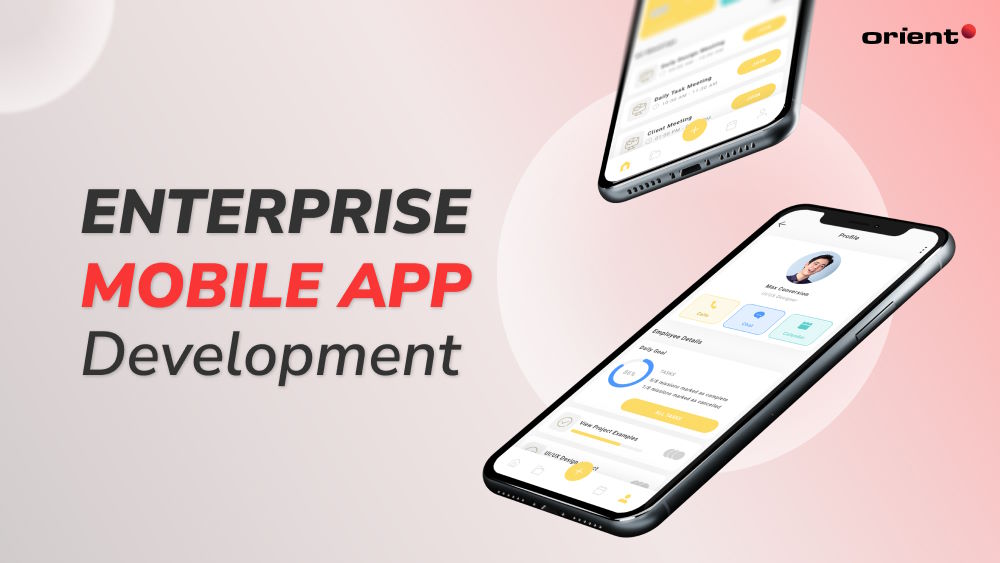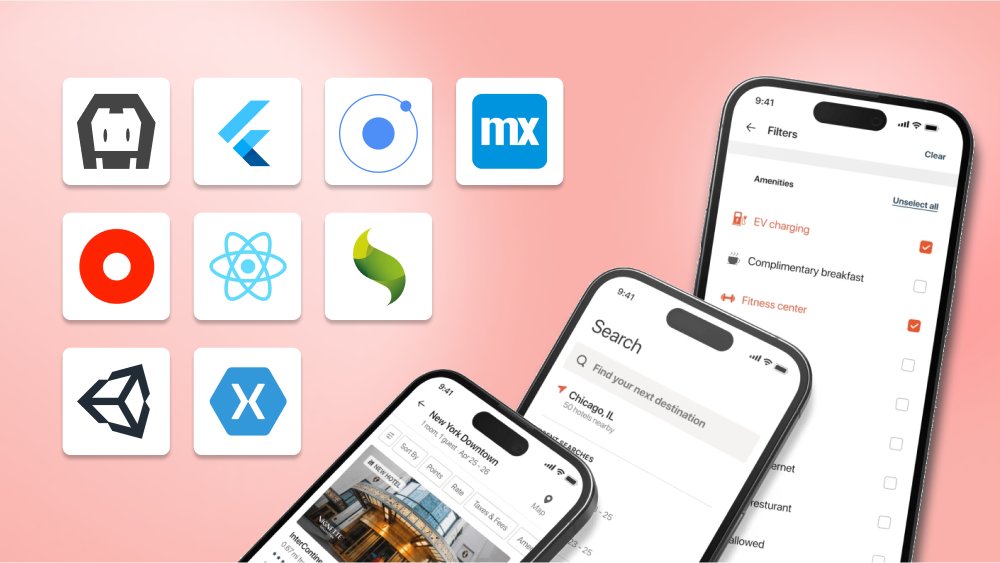A Reference Guide to Enterprise Mobile Application Development

Content Map
More chaptersLook around you; we are living in the “mobile-first” world, aren’t we? There have been massive waves of smartphones and mobile devices increasing each year. As reported by Statista, the global total number of active mobile devices stood at 15 billion in 2021, and it is anticipated to surge sharply to around 18 billion by 2025. With almost every activity nowadays being digitalized, ranging from healthcare, banking, shopping, and even education, then the answer must be a yes. And mobile applications now play a bigger role in the entrepreneur environment.
Some consider this as a great opportunity to ease business operations and growth, while many others see it as an inescapable scenario in which businesses of all sizes need to jump on the bandwagon of enterprise mobile application development or soon fall behind.
Whatever opinions you may have, businesses are in a hurry to capitalize on such opportunities presented by mobile technology. Hence, adopting mobile software solutions has shifted from a good-to-have to a must for any company that strives to thrive in today’s business realm.
Developing a successful enterprise mobile application involves more than just coding and programming. It includes creating well-thought-out strategies that will define the product roadmap, designing user interfaces (UI) that are both intuitive and attractive, offering user experience (UX) that meets the customer’s needs, and testing the app’s functionalities to make sure it works reliably. But above all, you need to gain an understanding of mobile enterprise application development beforehand. All the fundamentals needed to build enterprise mobile apps will be uncovered right after this.
What Is an Enterprise Mobile App?
First of all, do you need us to remind you of a mobile application? It is most commonly referred to as a mobile app or simply an app. Such a software solution is designed to operate on a small and wireless mobile device, such as a smartphone, tablet, or other gadget. Mobile apps enable users to perform specific tasks, and they are usually distributed through an app store or marketplace like Google Play Store and Apple App Store.
An enterprise mobile application (enterprise app) is the way a mobile app at the enterprise level and scale is defined. It is tailored to fit the business demands of an individual organization and is often only applied internally. The primary purposes vary on the business objectives, and some typical ones are to streamline business processes, improve internal collaboration and communication, enhance employee productivity, optimize resource allocation, safeguard company data, and so forth.
What sets enterprise applications from regular ones? Such apps are more powerful in data processing. They are more likely to include a large database and integrate it with other existing systems. It is also common for them to offer access control or privileged management functions, security measures, and user authentication.
Some prime examples of enterprise software that business owners can immediately relate to are customer relationship management apps, HR management apps, enterprise resource planning (ERP) apps, business management apps, etc.
Types of Enterprise Mobile Applications

Any enterprise application falls into one of the following common types: Native, Hybrid, Web-based, Responsive, or Cross-platform enterprise apps. Business owners rely on their needs to decide which type of mobile applications among these to put into practice.
Native Enterprise Apps
A native application is designed to run on a specific device (mobile platform) such as Android or iOS. It is built with programming languages and software development tools that are natively supported by its operating system. You can see that applications are written in Swift for Apple’s iOS, and apps are written in Java for Android. Oftentimes, native mobile applications are preferred when the highest level of user experience is desired because they are typically fast, reliable, and perform well, given that they have direct access to the device’s hardware and software features.
Web-Based Enterprise Apps
Web-based enterprise applications are usually browser-based mobile solutions that run within a standard web browser (such as Google Chrome). Such an app does not need to be explicitly installed from the app store or operate like typical websites but is optimized for mobile devices. These web applications are hosted on the web and used for enterprise operations.
Hybrid Enterprise Apps
Applications developed in the hybrid model inherit selected characteristics of both native and web apps. Developers use HTML, CSS, and JavaScript to build hybrid apps and wrap them in a native container that can be deployed on various platforms. As follows, software engineers can run hybrid apps on any platform with a single codebase. And hybrid apps are capable of accessing a device’s native features, such as camera, GPS, etc., through APIs provided by hybrid frameworks. Instagram and Uber are examples of hybrid mobile apps.
Responsive Enterprise Apps
These software applications are created with the nature to automatically adapt their layout and interface to the screen on which they are being accessed. Obviously, the goal of responsive design is to avoid unnecessary scrolling, zooming, or panning that occurs with sites that are not optimized for different devices.
Responsive enterprise applications are developed with web technologies, such as HTML5, CSS3, and JavaScript, plus a few extra libraries or frameworks like Bootstrap or AngularJS. The key principle is to create a single version of the web page that renders on all devices and platforms.
Cross-Platform Enterprise Apps
By definition, a cross-platform application is built with a write-once-run-anywhere (WORA) approach, meaning it has a shared codebase that can be used across multiple operating systems or platforms (like iOS, Android, or Windows). But unlike hybrid apps, they render using each platform’s native components. This makes them look and feel closer to native apps. Cross-platform apps also have better performance compared to hybrid apps since they don’t rely on a web view for rendering.
This type of app is developed using cross-platform development frameworks, such as Xamarin, React Native, and Flutter.
Three Levels of Enterprise Mobile Apps
Each and every organization has its own business model and operational processes, so its needs vary completely, case by case. Because of that, the requirements and needs of an organization can be leveled and divided into three categories with distinct complexity and scenarios, namely employee, department, and business levels.
In the following section, let’s walk through each level to see how mobile enterprise applications revolutionize various segments of the entire organizational operations. Therein, we can ascertain the benefits of implementing an enterprise solution in the business environment.
Employee Level
The very first level of mobile applications used in the business environment is the staff-level ones. As their names imply, these are mobile software solutions created to simplify and enhance the daily workflow of employees, ranging from communication, collaboration, and productivity to task management.
Enterprise apps at this level comprise task-oriented software solutions which come in handy for people in a specific position and help them to solve one or several particular issues. In specific, some typical usages of an employee-level app could be enabling field staff to submit reports on the go, the sales team to conduct online product demos from afar, or even HR specialists managing the HR process from the convenience of their smartphones and so forth.
The most straightforward example to relate to is the messaging application in a corporate environment. Microsoft Teams, for example, is a prevalent channel used to communicate within the company. It provides an array of features enabling teams to stay connected wherever they are, such as direct messaging, voice/video calls, sharing documents and files in real-time, etc., not to mention the data security mechanisms complying with the company’s policy.
Department Level
The second tier of enterprise mobile apps is tasked to streamline and automate the operational processes of a particular department instead of individuals. These applications are created to become a single platform in which multiple departments can collaborate seamlessly and be on the same page instead of running silos.
The standard features to be included in such mobile applications are data integration, cloud storage, process automation, workflow streamlining, and the like. Furthermore, since these apps are created to be used across multiple departments in an organization, they usually have built-in features that support numerous users simultaneously. This is highly beneficial for decision-makers who need an overview of different operations without having to jump from one system/platform to another.
Management Level
The enterprise apps at this level are created as a centralized network or tool for business owners, managers, and leaders to gain insight into the operations of their departments and teams. These applications are diverse in functions, so they are built differently with respect to their ultimate goals – streamline the operational management activities and automate as much manual administrative work as possible. Thus, the software is often tailor-made to solve the specific problems of an organization, which can be employee performance tracking, asset management, financial operations monitoring, customer data analysis, etc.
In a modern business environment, employers enable staff to perform tasks from any location using their preferred devices, such as smartphones, tablets, laptops, or other smart devices alike. And enterprise mobility solutions, for example, are a suite of tools and software designed to manage and support the use of personal mobile devices within a company while ensuring data security and compliance with business regulations.
On the whole, a complete app management ecosystem for a business is usually formed of several solutions (of various types and functions), and they work in tandem.
Approaches to Building Enterprise Mobile Applications

Business leaders can take different paths toward the enterprise mobile development goal. Here, we outline the two primary yet most popular approaches to tackle corporate system development.
Off-the-shelf Corporate Systems
The easiest and fastest way to get your business an enterprise-scale application. However, it is not a budget-friendly method anyway. The approach involves selecting and purchasing pre-made software solutions available on the market. These general-purpose applications are created and configured to meet a variety of business needs; that’s why they are called ready-made or off-the-shelf solutions. They are often easier to integrate with existing systems within an organization.
Needless to say, these pre-built systems are typically cheaper, easier, and faster to implement in a company environment. Its advantages are also downsides, as this category of software may not fully satisfy the unique needs. You can make basic customization to such mobile apps; however, asking for a higher level of freedom and flexibility in customization is a luxury with this option.
Custom Built Enterprise Software
Custom or bespoke solutions are those designed and built specifically for an organization. This is no better choice for companies that require exclusive features or have unique expectations for their mobile applications rather than having to conform to ready-made ones. Developing the enterprise mobile application in this way puts you in total control and allows you to customize the outcome to exactly what you had in mind initially.
In this approach, business owners have two different methods to bring their enterprise applications to life. The former is to build a technological solution from scratch with an in-house development team. The latter is to contract outsourced enterprise mobile app developers and delegate the entire development process to them. Either way has upsides and downsides, so you’d better choose wisely.
Commenting on outsourcing models, you can grasp more advantages and flexibility than when you conduct a project completely with in-house resources. Notably, cost-saving is the most tangible benefit driving many organizations to have their software solutions developed by external teams.
How to Estimate & Calculate the Enterprise App Development Costs
The total development cost of a custom software product is dominated by various factors, so it will be impossible to give you an exact figure for every case. Instead, you can use your own measurements to forecast your expenditure and plan your budget as closely as possible for the future.
And fortunately, there is a common formula enabling you to calculate the total estimate after identifying all the variables that might affect your development cost:
Cost = Development Time (Hours) x Hourly Rate
Or you can use available online app cost calculators to give a basic estimation. For example, How Much to Make an App. According to the majority opinions on Clutch, the average market price for developing a custom application is somewhere under $200,000. But the actual price can be much higher in reality. It can cost up to $350,000 for a simple app with multiple functions, as referred to in the calculator tools. As such tools indicate, the total development cost of an enterprise application possibly exceeds the amount of $350,000. Keep in mind that the findings from online tools are only generally accurate, so you should not totally rely on them.
Outsource Enterprise Mobile App Development to Orient Software
Is your business gearing up for a big technological stride? Come to Orient Software. We are holding the key to unleashing your true potential to grow as a tech-driven organization. From the very early days until now, our company has been providing clients from all around the world with quality services at a rational price. Our service range is versatile, ranging from custom software development to mobile app and web app development, from UI/UX design to QA testing, and from artificial intelligence to IoT and data science. All can be customized and tailored to your specific needs.
As an IT powerhouse and also your trustworthy partner, we are committed to staffing your project with top experts whose domain knowledge and experience are the most suited. Tell us what you need, and we will figure out the right solution for you. Contact us now and join the growing number of satisfied customers who have already entrusted us with their enterprise mobile application development projects – we are ready to assist you.







